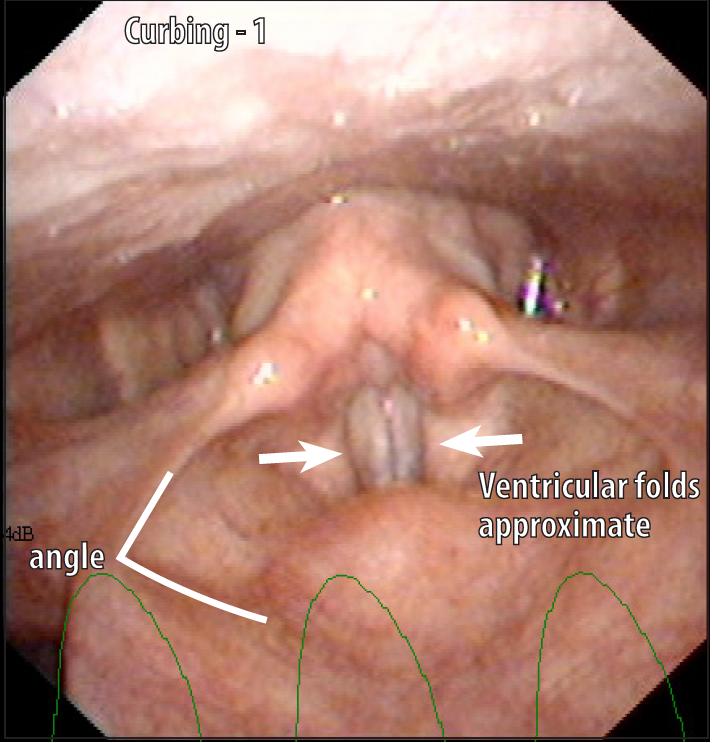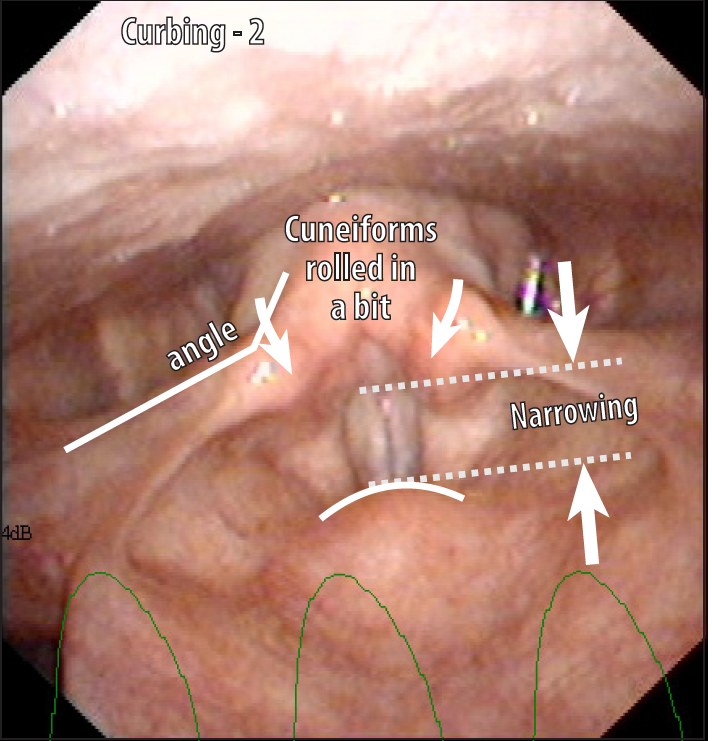Methods
In June 2007 Julian McGlashan and Cathrine Sadolin performed an endoscopy study at CVI in Copenhagen.
Twenty singers (ten males and ten females) trained in the Complete Vocal Technique were recruited and asked to produce a sustained vowel in each mode. Each singer was instructed to produce the mode as perfect (near to the centre of the mode) as possible with minimal additional effects, twang and extremes of sound colour. The larynx was imaged using a videonasoendoscopic camera system (OTVS7 camera and ENFV2 videoscope from Olympus/Keymed) and the Laryngostrobe system (from Laryngograph Ltd) used for image capture.
Three subjects were excluded as they could either not tolerate the examination (1) or the image quality was not adequate for interpretation (2).
When looking at these videos certain patterns were seen in the laryngeal gestures within each mode. A still image for each of the modes was produced from the videos. The still images were chosen by listening to the sound without seeing the images and extracting the stills when the sound was as close to the centre of the mode as possible.
Each set of five (Neutral with and without air were viewed separately) video images were analysed by Julian McGlashan and Cathrine Sadolin and the appearance and relationship between the key anatomical features was agreed by consensus and documented. The consistent features were identified and schematic drawings produced with descriptive and explanatory text to aid pattern recognition.
Then these laryngeal gestures were schematized by the most obvious gestures (the ’first glance’) and then further examined and categorized into what could be seen at a ‘second glance’.
We gave the various parts in the vocal tract levels in order to identify and specify on which levels the various changes take place. The levels also make it easier to communicate where the changes take place. On the stills from the footage only the first 3-4 levels are seen.
To indentify the structures on the endoscopic images see the anatomy of the larynx.
The ‘first glance’ features on the laryngeal gestures in Curbing on the levels are:
 Level 1
Level 1
- Vocal folds seen along most of their length.
- The vocal folds seem narrower from front to back (anterior-posterior).
- There is also narrowing in width with some loss anteriorly
- The vocal folds appear more elongated and rectangular in shape
Level 2
- False folds are less retracted (straighter) giving more rectangular appearance
Level 3
- Arytenoid cartilages are together
In everyday language:
The false folds approach each other slightly, covering some of the vocal folds.
The front and the back of the structures above the vocal folds approach each other, making the angle more acute between the aryepiglottic folds and the lower part of the epiglottis.
The ‘second glance’ features on the laryngeal obvious gestures in Curbing on the levels are:
Level 3
- Annterior-posterior narrowing between petiole and arytenoid/cuneiform complex
- The cuneiform cartilages are more anteromedial to the arytenoids
- More contact between arytenoid tip and posterior pharyngeal wall
Level 4
- Piriform sinuses less open
In everyday language:
The opening of the larynx is generally more narrowed, creating an angle between the arytenoids and the aryepiglottic folds. The cuneiform cartilages are rolled forward a little on top the cuneiforms are rolled in a bit.
The laryngeal gestures in Curbing without drawings

This information comes from a study Visual Vocal Mode Test Study on stills, with the title ‘Laryngeal gestures and Laryngograph data associated with the four vocal modes as described in the Complete Vocal Technique method of singing teaching’. This study was presented by Cathrine Sadolin and Julian McGlashan at BVA ‘Choice for voice’ conference in London, England, 2010.

